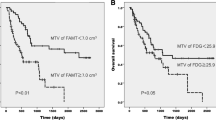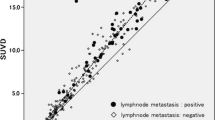Abstract
Purpose
The aim of this study was to evaluate FDG-PET for assessment of therapy response and for prediction of patient outcome after neo-adjuvant radio-chemotherapy (NARCT) of advanced non-small cell lung cancer (NSCLC).
Methods
Seventy patients with histologically proven stage III NSCLC underwent FDG-PET investigations before and after NARCT. Changes in FDG uptake and PET findings after completion of NARCT were compared with (1) the histology of tumour samples obtained at surgery or repeat mediastinoscopy, and (2) treatment results in terms of achieved operability and long-term survival.
Results
The mean average FDG uptake of the primary tumours in the patient group decreased significantly during NARCT (p = 0.004). Sensitivity, specificity and overall accuracy of FDG-PET were 94.5%, 80% and 91%, respectively, for the detection of residual viable primary tumour, and 77%, 68% and 73%, respectively, for the presence of lymph node metastases. A negative PET scan or a reduction in the standardised uptake value (SUV) of more than 80% was the best predictive factor for a favourable outcome of further treatment. Progressive disease according to PET (new tumour manifestations or increasing SUV) was significantly correlated with an unfavourable outcome (p = 0.005). In this subgroup, survival of patients who underwent surgery was not significantly different from survival among those who did not undergo surgery, whereas for the whole patient group, complete tumour resection had a significant influence on outcome.
Conclusion
FDG-PET is suitable to assess response to NARCT in patients with stage III NSCLC accurately. It was highly predictive for treatment outcome and patient survival. PET may be helpful in improving restaging after NARCT by allowing reliable assessment of residual tumour viability.




Similar content being viewed by others
References
Saunders CA, Dussek JE, O’Doherty MJ, Maisey MN. Evaluation of fluorine-18-fluorodeoxyglucose whole body positron emission tomography imaging in the staging of lung cancer. Ann Thorac Surg 1999;67:790–7.
Schrevens L, Lorent N, Dooms C, Vansteenkiste J. The role of PET scan in diagnosis, staging, and management of non-small cell lung cancer. Oncologist 2004;9:633–43.
Bury T, Dowlati A, Paulus P, Corhay JL, Hustinx R, Ghaye B, et al. Whole-body 18FDG positron emission tomography in the staging of non-small cell lung cancer. Eur Respir J 1997;10:2529–34.
Lewis P, Griffin S, Marsden P, Gee T, Nunan T, Malsey M, et al. Whole-body 18F-fluorodeoxyglucose positron emission tomography in preoperative evaluation of lung cancer. Lancet 1994;344:1265–6.
Pieterman RM, Van Putten JW, Meuzelaar JJ, Mooyaart EL, Vaalburg W, Koeter GH, et al. Preoperative staging of non-small cell lung cancer with positron emission tomography. N Engl J Med 2000;343:254–61.
Hicks RJ, Kalff V, MacManus MP, Ware RE, McKenzie AF, Matthews JP, et al. 18F-FDG-PET provides high-impact and powerful prognostic stratification in staging newly diagnosed non-small cell lung cancer. J Nucl Med 2001;42:1596–604.
Hoekstra CJ, Stroobants SG, Hoekstra OS, Vansteenkiste J, Biesma B, Schramel FJ, et al. The value of [18F]fluoro-2-deoxy-D-glucose positron emission tomography in the selection of patients with stage IIIA-N2 non-small cell lung cancer for combined modality treatment. Lung Cancer 2003;39:151–7.
Eschmann SM, Friedel G, Paulsen F, Budach W, Harer-Mouline C, Dohmen BM, et al. FDG-PET for staging in patients with advanced non-small cell lung cancer (NSCLC) scheduled for neoadjuvant radio-chemotherapy. Eur J Nucl Med Mol Imaging 2002;29:804–8.
Schmucking M, Baum RP, Griesinger F, Presselt N, Bonnet R, Przetak C, et al. Molecular whole-body cancer staging using positron emission tomography: consequences for therapeutic management and metabolic radiation treatment planning. Recent Results Cancer Res 2003;162:195–202.
Vansteenkiste JF, Stroobants SG, Dupont PJ, De Leyn PR, Verbeken EK, Deneffe GJ, et al. Prognostic importance of the standardized uptake value on 18F-fluoro-2-deoxy-glucose-positron emission tomography scan in non-small-cell lung cancer: an analysis of 125 cases. J Clin Oncol 1999;17:3201–6.
Higashi K, Ueda Y, Arisaka Y, Sakuma T, Nambu Y, Oguchi M, et al. 18F-FDG uptake as a biologic prognostic factor for recurrence in patients with surgically resected non-small cell lung cancer. J Nucl Med 2002;43:39–45.
Higashi K, Ueda Y, Yagishita M, Arisaka Y, Sakurai A, Oguchi M, et al. FDG-PET measurement of the proliferative potential of non-small cell lung cancer. J Nucl Med 2000;41:85–92.
Ahuja V, Coleman RE, Herndon J, Patz EF. The prognostic significance of fluorodeoxyglucose positron emission tomography imaging for patients with non-small cell lung carcinoma. Cancer 1998;83:918–24.
Jeong HJ, Min JJ, Park JM, Chung JK, Kim BT, Jeong JM, et al. Determination of the prognostic value of [18F]fluorodeoxyglucose uptake by using positron emission tomography in patients with non-small cell lung cancer. Nucl Med Commun 2002;23:865–70.
Martini N, Bains MS, Burt ME, Zakowski MF, McCormack P, Rusch VW, et al. Incidence of local recurrence and second primary tumors in resected stage I lung cancer. J Thorac Cardiovasc Surg 1995;109:120–9.
Komaki R, Cox JD, Hartz AJ, Byhardt RW, Perez-Tamayo C, Clowry L, et al. Characteristics of long-term survivors after treatment for inoperable carcinoma of the lung. Am J Clin Oncol 1985;8:362–70.
Vesselle H, Schmidt RA, Pugsley JM, Li M, Kohlmyer SG, Vallires E, et al. Lung cancer proliferation correlates with [F-18] fluorodeoxyglucose uptake by positron emission tomography. Clin Cancer Res 2000;6:3837–44.
Higashi K, Ueda Y, Ayabe K, Sakurai A, Seki H, Nambu Y, et al. FDG-PET in the evaluation of the aggressiveness of pulmonary adenocarcinoma: correlation with histopathologic features. Nucl Med Commun 2000;21:707–14.
Keyes JW Jr. SUV: standard uptake or silly useless value? J Nucl Med 1995;36:1836–9.
Ruy JS, Choi N, Fischman AJ, Lynch TJ, Mathisen DJ. FDG-PET in staging and restaging non-small cell lung cancer after neoadjuvant chemoradiotherapy: correlation with histopathology. Lung Cancer 2002;35:179–87.
Akhurst T, Downey RJ, Ginsberg MS, Gonen M, Bains M, Korst R, et al. An initial experience with FDG-PET in the imaging of residual disease after induction therapy for lung cancer. Ann Thorac Surg 2002;73:259–64.
Port JL, Kent MS, Korst RJ, Keresztes R, Levin MA, Altorki NK. Positron emission tomography scanning poorly predicts response to preoperative chemotherapy in non-small cell lung cancer. Ann Thorac Surg 2004;77:254–9.
Pottgen C, Levegrun S, Theegarten D, Marnitz S, Grehl S, Pink R, et al. Value of 18F-fluoro-2-deoxy-D-glucose-positron emission tomography/computed tomography in non-small-cell lung cancer for prediction of pathologic response and times to relapse after neoadjuvant chemoradiotherapy. Clin Cancer Res 2006;12:97–106.
Cerfolio RJ, Bryant AS, Winokur TS, Ohja B, Bartolucci AA. Repeat FDG-PET after neoadjuvant therapy is a predictor of pathologic response in patients with non-small cell lung cancer. Ann Thorac Surg 2004;78:1903–9.
Hoekstra CJ, Stroobants SG, Smit EF, Vansteenkiste J, van Tinteren H, Postmus PE, et al. Prognostic relevance of response evaluation using [18F]-2-fluoro-2-deoxy-D-glucose positron emission tomography in patients with locally advanced non-small-cell lung cancer. J Clin Oncol 2005;23:8362–70.
Hellwig D, Graeter TP, Ukena D, Georg T, Kirsch CM, Schafers HJ. Value of F-18-fluorodeoxyglucose positron emission tomography after induction therapy of locally advanced bronchogenic carcinoma. J Thorac Cardiovasc Surg 2004;128:892–9.
Bilger K, Kupferschlaeger J, Mueller-Schauenburg W, Nuesslin F, Bares R. Threshold calculation for segmented attenuation correction in PET by histogram fitting. IEEE Trans Nucl Sci 2001;48:43–50.
Langen KJ, Braun U, Rota Kops E, Herzog H, Kuwert T, Nebeling B, et al. The influence of plasma glucose levels on fluorine-18-fluorodeoxyglucose uptake in bronchial carcinomas. J Nucl Med 1993;34:355–9.
Tsuchida Y, Therasse P. Response evaluation criteria in solid tumors (RECIST): new guidelines. Med Pediatr Oncol 2001;37:1–3.
Eschmann SM, Friedel G, Paulsen F, Reimold M, Hehr T, Budach W, et al. Is standardised 18F-FDG uptake value an outcome predictor in patients with stage III non-small cell lung cancer? Eur J Nucl Med Mol Imaging 2006;33:263–9.
Junker K, Langner K, Klinke F, Bosse U, Thomas M. Grading of tumour regression in non-small cell lung cancer: morphology and prognosis. Chest 2001;120:1584–91.
Author information
Authors and Affiliations
Corresponding author
Rights and permissions
About this article
Cite this article
Eschmann, S.M., Friedel, G., Paulsen, F. et al. 18F-FDG PET for assessment of therapy response and preoperative re-evaluation after neoadjuvant radio-chemotherapy in stage III non-small cell lung cancer. Eur J Nucl Med Mol Imaging 34, 463–471 (2007). https://doi.org/10.1007/s00259-006-0273-5
Received:
Accepted:
Published:
Issue Date:
DOI: https://doi.org/10.1007/s00259-006-0273-5




